robdhc
Part of things
 
Posts: 198 
|
|
Sept 9, 2023 21:11:58 GMT
|
In addition to the welcome distraction of getting the golf back on the road (no progress today mind) I have been slowly chipping away at the house An executive decision has been made that given we paid enough for the tiles (and trust me we have...) it's not worth risking me cocking them up. So the bathroom is on complete standstill - frustrating but I'll not complain too much. Equally, after my disasterclass with the skirting boards in our bedroom, I'm not permitted to do any of the finishing touches such as architrave, coving, etc. Even me painting is considered a last resort! If I say so myself, though completely unintentional, I may have played a blinder here... Some say that if you do a job bad enough the first time you'll never need to do it again, well I may have just got myself out of all decorative DIY for life 😎 The raised nuts for the box frame did, despite all the sounds suggestions above (thank you all), has I think solved itself in the end. Once the plasterboard had been fitted and skimmed, they sit near enough flush to the wall such that by the time skirting is up it'll be under that. Underlay and carpet will hide any protrusion, but I don't need to worry about either of those wearing through now since they'll be no traffic passing over  Our plasterer has been back often, continuing at pace when here, unlike the sparky. We are however very nearly ready for changeover once he returns - hopefully just the one visit left now (will get photos of new CU tomorrow). Am debating the need for some of the kit installed outside, but it's in and we're so near to being done now. Then it'll just be a case of pinning down the plumber for our boiler install...  On the topic of hot water and electricity, I'm properly kicking myself for some poor (in my mind) decision making. Quite early on (ie before moving in) we decided to move away from heating oil currently used in the property. Our previous place only had water and electricity, and I'm a simple chap who likes the simplicity of two bills and only two points of reliance - plus only two systems to go wrong. Also, if electricity is to be the new sustainable future, why not embrace it now? Expensive, but just about justifiable to us I wasn't convinced that the technology for ground/air source heatpumps was developed enough yet, though a government grant may have swayed that one. Three phase electricity was something I seriously considered too, makes finding a suitable boiler much easier, allows for fast EV charging if we ever go that way, and future-proofed any dreams of a workshop at the bottom of the garden. However, given I'd be paying for what seemed like upgrading the power supply to the village, that was quickly discounted also. For reasons I cannot fathom, I then completely overlooked the option of storage heaters / electric radiators (EVEN THOUGH IT'S WHAT WE HAD IN OUR PREVIOUS HOUSE) and landed on the option of one electric boiler for 'domestic' purposes and another for heating. Perhaps this is still the way to go, but to my simple mind a) it must be far more energy inefficient, and thus far far more expensive and b) it's another system that might fail (resulting in a wet house*) as opposed to a tripping circuit. I'd even considered electric UFH before discounted that on grounds of inaccessibility if things went wrong [rant ends**] * more wet house [new rant begins] The damp has not gone away. We did no treatment whatsoever, so it wasn't really expected to be solved. However, having had two 'experts' provide two completely differing views, both at extortionate cost, I figured the best thing to do would be live in it and see what's what. The wishful thinking was that having people live in it and use it would make a marked improvement, but alas that is not the case. Having stripped the walls back to bare brick for the bottom half of downstairs, and the complete chimney breasts, it quickly became apparent that, not only was there an original (slate) DPC there had also been an injected DPC added at some point. This was the final nail in the coffin of "sod it, we'll just see what happens". What's happened has left me more confused, but equally more affirmed that paying 10,000,000+ pennies would unlikely resolved the problems. It's not rising damp, with the possible exception of a single wall in the kitchen, and I still can't see how it can be penetrating damp with the impermeable tyrolean plastered all over the exterior. Patches, seemingly random in location, have appeared. Most seem to be at around waist height, just above or just below where the old plaster meets the new. No pattern, no consistency, just patches of damp. For this reason the kitchen will remain in its current temporary guise, and the lounge will remain a dusty mess - now workshop instead of bed4 (all of upstairs will now be plastered and finished off)  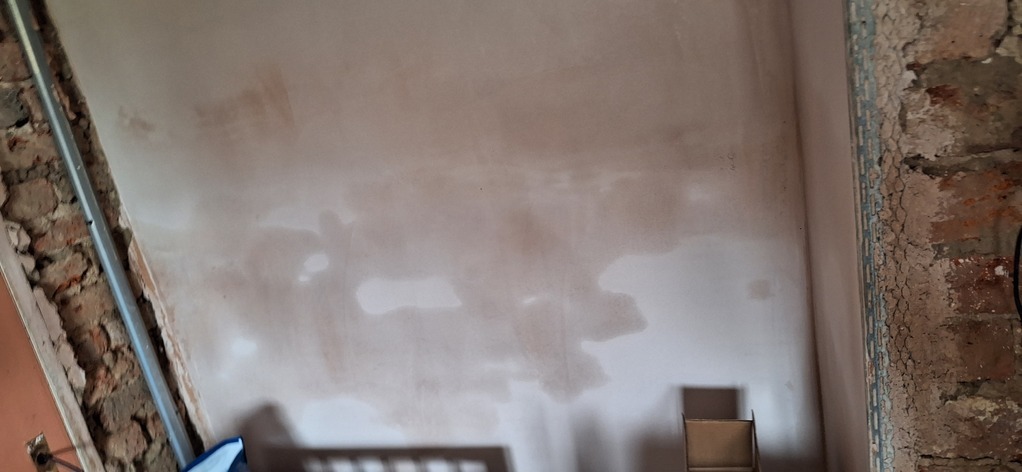 ** I started writing this up yesterday, before fitting radiator #2 today. All went well, perfectly central, level with the sill (not level level, but that's another story) etc. Then all lined up ready for the pipework, only to find a direct clash with a joist. So radiator can't be central, needs to be as pic below. Then, drilling in floorboards for new position and have managed to go straight through a pipe  With all of the above in mind, am I better off cutting my losses (call it £500 and a few days work running pipes) and changing up for electric heaters? It'd be a hell of a lot easier to do now that later, and in my simple mind is just a case of spurring off the circuits already running under the floorboards With all of the above in mind, am I better off cutting my losses (call it £500 and a few days work running pipes) and changing up for electric heaters? It'd be a hell of a lot easier to do now that later, and in my simple mind is just a case of spurring off the circuits already running under the floorboards All in all, it was messy and stagnant, and isn't much more organised now, but progress is progress, however slight? Cheers, Rob Bonus Scenes to apologise for multiple rants - random shenanigans since last update. Including mates over for general childishness, alpacas moving in across the road, and some of the fruits from someone else's labour     Broken deck already? Plus garden waste clearance, there's another 3 or 4 in the car - they were heavy! 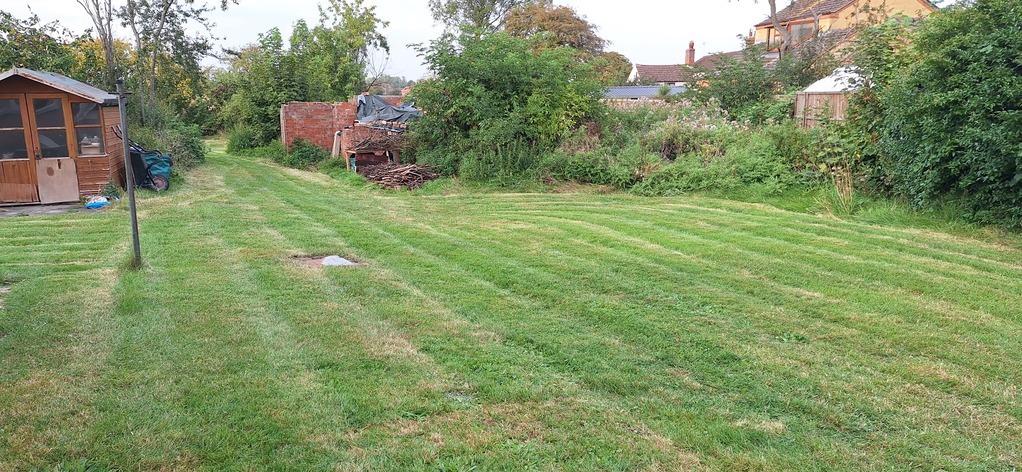  Perhaps a more positive update tomorrow once I've found my dummy! |
| |
Last Edit: Sept 9, 2023 21:21:09 GMT by robdhc
|
|
|
|
glenanderson
Club Retro Rides Member
Posts: 4,368
Club RR Member Number: 64
|
Wing Commander HQglenanderson
@glenanderson
Club Retro Rides Member 64
|
Sept 10, 2023 1:28:27 GMT
|
|
You can’t spur electric heaters off your ring main. You’ll need to run new feeds from a dedicated consumer unit.
As for your radiator placement, the answer is to buy a pipe bender so that you can put the rad in the right place, and send the pipes to where they need to be.
As for the damp, it’s likely to be a combination of your breathing, and the tyrolean outside preventing the walls from breathing.
|
| |
My worst worry about dying is my wife selling my stuff for what I told her it cost...
|
|
robdhc
Part of things
 
Posts: 198 
|
|
Sept 10, 2023 8:12:40 GMT
|
You can’t spur electric heaters off your ring main. You’ll need to run new feeds from a dedicated consumer unit. As for your radiator placement, the answer is to buy a pipe bender so that you can put the rad in the right place, and send the pipes to where they need to be. As for the damp, it’s likely to be a combination of your breathing, and the tyrolean outside preventing the walls from breathing. Thanks Glen, appreciate the early feedback For heating, I was simply thinking something like this (first one on amazon but you get the idea) just hardwired rather than using a plug, off a fused spur if necessary. Each room will be on it's on radial circuit so shouldn't be overloading any circuits Bending the pipe is something I had considered, but the radius on the one I have is too big. Hadn't considered a smaller one though, will see if I can get my hands on one Damp is almost certainly the tyrolean yea, one day we'd probably like to strip it off - the unknown being the state of the brickwork behind it Cheers, Rob |
| |
|
|
glenanderson
Club Retro Rides Member
Posts: 4,368
Club RR Member Number: 64
|
Wing Commander HQglenanderson
@glenanderson
Club Retro Rides Member 64
|
Sept 10, 2023 9:03:19 GMT
|
|
Hi Rob.
That link just brings me back here?
Electricity is an expensive way to heat rooms, unless you have a tariff that gives you access to a cheap rate at certain times. Storage heaters work well enough (lack of rapid controllability aside), but to make them affordable they need to be fitted in such a way as to take advantage of your supplier’s cheap overnight rates.
If your pipe bender won’t give you the right radius curves, then use solder fittings to tuck the pipes around under the radiator and down to the underfloor pipes somewhere else. If you don’t want to solder, or don’t like the look of the copper coloured pipes, then use chrome plated compression fittings and make a feature of them.
Keep up the good work. 👍
|
| |
My worst worry about dying is my wife selling my stuff for what I told her it cost...
|
|
jamesd1972
Club Retro Rides Member
Posts: 2,922  Club RR Member Number: 40
Club RR Member Number: 40
|
Wing Commander HQjamesd1972
@jamesd1972
Club Retro Rides Member 40
|
Sept 10, 2023 9:32:51 GMT
|
|
If too tight to bend then a pair of 90 elbows will work as well. Not as nice as a bend to some people but you can do the soldering if using yorkshire fittings somewhere else and end up with the rad in the centre.
People will notice an off centre rad but not some pipework under it most of the time !
On your door frame could you get a welder out and remove the overlap in the middle ? I've used machined oak or similar as a door step as it allows a transition between rooms with the same flooring or a change easily and a few mm higher to hide details like this.
All progress is good progress, keep up the good work.
James
|
| |
Last Edit: Sept 10, 2023 9:34:37 GMT by jamesd1972
|
|
|
|
|
Sept 10, 2023 12:30:41 GMT
|
|
Its all taking shape, as glen said above everything we do in a house produces moisture and then everyone tries to seal the place up like an air tight box, the moistures got to go somewhere so it will condensate at the cold points which is normally the outside walls, try a dehumidifier that may help?
The other thing could be where the external paths/concrete is tight up to the house when it rains the water splashes back up onto the walls higher than the damp course and again with the external coating the walls can breath so sometimes it helps to cut the paths back 10 inches and fill with gravel which stops the splashback, its the joys of owning and older property and inheriting other peoples work/bodges, tell me how I know!
With heating we don't have mains gas so use oil which seems to be reasonably cost effective with a modern boiler, I think electric heating will always be expensive and have its draw backs but perhaps I'm just old!
Which bit of Lincs did you end up in?
|
| |
|
|
|
|
|
Sept 11, 2023 8:10:41 GMT
|
Well although I was doubtful, having seen a decline in recent years of the service 'Heritage Parts Centre' offer (noting it largely seemed to have dropped off since that change) I can't complain this time round. Only minor nuisance was having to message the returns department rather than an email to the general help account - surely it could have been forwarded on - but beyond that been pretty faultless. New part sent out no questions asked (I submitted a photo) via next day delivery It was a pleasant job, delayed only by a Chinese takeaway Things of interest (subjective) was that one nut was tighter - psr - which corresponded with a not quite flush fitment as below. Time will tell if a conscious effort to not overtighten them pays off  Also of interest was the fact that the split didn't appear to reach all the way through, so may not be the root cause after all... 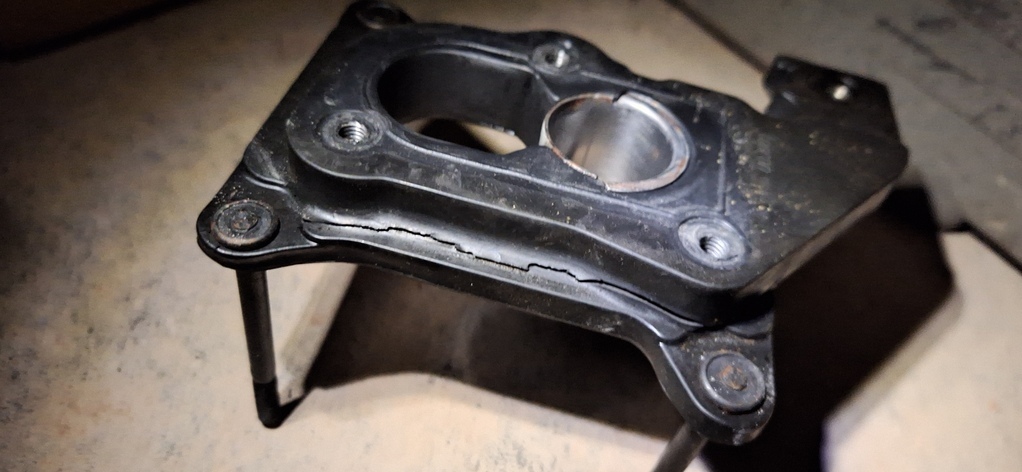  miniman31 miniman31 that sounds an avenue to explore, I'm not aware of any bracket so unsure what you mean here. Any photos by any chance please? It does seem solid enough, but I'm no expert by any stretch of the imagination. I did spot a redundant (rightly or wrongly) embedded nut on the flange, any idea if this a possible culprit also? Sadly no time to test today, so it'll have to be tomorrow if time permits. Plans involve more tinkering with services to enable the dressing room floor to go down, and a long overdue grass cut I do also intend at some point this weekend to do a proper update on the house front, not that there's a load to update on! Cheers for now Rob Hi Rob, Ignore what I said as I just realised yours is a 1.3 and my 1.6 has a different inlet, rubber mount and airbox to yours so it is all irrelevant sorry. That unused mounting hole is suspect though, but I cannot find anything on parts diagrams to work out what I might connect to. If the mount wasn't split all the way through then it may not have been the issue but hope the new part soves it. Regards, Jordan |
| |
|
|
robdhc
Part of things
 
Posts: 198 
|
|
Sept 28, 2023 19:47:22 GMT
|
I'm well overdue a proper update at some point, and in doing so I'll make sure to reply to everyone properly as your input is all very much appreciated For now, I'll share this pic which sums up how things are going at the moment...  On route to an MOT for the Audi to see how bad it was before I take it off the road Exciting times! Cheers, Rob |
| |
|
|
|
|
|
|
|
|
you are lucky enough to have a large enough plot for a ground source heat pump, they are about the best option out there, whatever you do the best value to start with will be insulation and some sort of heat recovery ventilation system which should also help with the damp issues.
On older houses I've been batoning the inside of the outside walls, then stapling up mutifoil, counter batoning and plasterboarding, gives a high level of insulation for not much space lost.
|
| |
|
|
robdhc
Part of things
 
Posts: 198 
|
|
|
|
So if it wasn't clear already by now, I think it's becoming obvious that I'm the RR apprentice. Sadly not the 'will one day become a master' variety, more the ' tried and failed spectacularly' type Rather than quoting each reply (all are very much appreciated and your collective guidance has been invaluable in terms of insight and motivation) I'll break this post across the various different topics covered HeatingGas - not an option Oil - isn't something we're going to use (happy to go into why we've chosen that but not particularly exciting) Ground/Air source heat pumps - I'm just not convinced the technology is accessible yet. To me it feels like electric cars, close but not quite there, with the risk it becomes the next blu-ray Electric Combi-Boiler - would be preferred choice but needs to be three phase. Did explore this (especially with longer term goals of workshop in garden as well as EV charging) but think we'd end up paying National Grid to run cable from nearest DNO (not a massive distance, but not cheap) Electric Heating only Boiler - currently most likely as I've already run all the pipework upstairs for rads. Dislike idea of another wet system (risk of leaks), inefficient, lack of room-by-room smart controllability, general faff of installation (particularly downstairs) Electric Storage Heaters - would need a dedicated circuit (missed chance for this to be done neatly), lacks rapid controllability as mentioned by glenanderson, we had it in our last place and could get it setup as we wanted Electric Panel Heaters - this is almost certainly the one I'd go for if electricity weren't so expensive. But it is, so not currently viable - maybe if the nation works towards a stronger supply infrastructure (both physically and economically) it's something I can go back to. Solar panels not currently an option as a) I don't have the cash and b) suspect roof would need strengthening/redoing first to enable this After multiple targeted ads, Fischer are a company who seem to provide all of the options still in consideration, so I've a free survey from them on Monday. Having since googled them rather than following ad links, I'll take what they say with a pinch of salt and likely leave it there Link for completeness glenanderson r.e. electric panel heaters amzn.eu/d/7KiUfNEThe dressing room radiator I'm still procrastinating over - it's a blessing and a curse that there's so much other stuff to be getting on with! As it's visible, it'll also need sign-off from the boss too DampGiven we'd done no remedial/preventative work in this regard it shouldn't be a surprise, it's why we haven't done the lounge or under the stairs. Given most of our washing is left to dry inside, the baby's bottle feeder is effectively a small kettle, and we spend most of our time in there (breathing and the like) I absolutely concur with all comments made. We've had a dehumidifier (at times two) running pretty much 24/7 but humidity readings are still usually 71% to 73%. This is all in the kitchen, but biggest current pain point is the hallway ceiling (no photos unfortunately). There are two things I think/hope are contributing to this 1) damaged felt in loft space above, not letting water I don't think, but perhaps spray or something 2) patch is right at top of chimney down into kitchen. Could humidity from kitchen be rising up through stack then condensing in cold loft space? Planned rectification as follows... 1) Roof repair 2) Better insulation in roof (original is now back down, plus another 200mm ready to go up) 3) Heating - a consistent temperature should help 4) French-drain style system, got someone lined up to come and do this soon hopefully 5) Extractor fans in kitchen & downstairs shower room, which backs on to kitchen Stripping off the external render is also still potentially on the cards, but it's not a job planned for any time soon With regards your batten & board kevins , presumably this has been done directly to bare brick as opposed to over plaster? Also, how have you (if you're needed to) tackle damp on interior walls? We have damp on an original single-depth brick built internal wall, as well as a now internal wall that used to be external.. Heat recovery ventilation is something I need to educate myself on jamesd1972 - I'm not sure my welding skills would be up to that, it's been a long time since I did any and even that was only ever self-taught practice. Fortunately, I'm pretty sure the box-frame is a non-issue now, to be hidden away by a combination of carpet and skirting gtviva - we're about 10mins south of Sleaford or 30mins east of Grantham, marginally outside our original search area but still a handy enough location miniman31 - no, thank you, the logic of what you've said still applies to this. Sadly I've just not had time to tinker with it any more recently. Had to shift it across the yard for a delivery on Friday, buy wouldn't start. Still, quickly approaching 2nd most reliable of them all! I'll let some photos do the rest of the updates - as always all feedback very much appreciated and any questions always welcomed too (even if it's "What on earth possessed you to do that?!")  Roof patches required, since attempted but no after photos   Reckon 'extreme cutting in' could be an Olympic sport  Getting this switched on was an exciting milestone. And we now have an oven!   These disappeared pretty quickly when left out by the pavement (way too many for us, and more still to come)  Can assume we're in for a treat when the tyrolean does eventually come off...  A decent selection in amongst all the weeds  Power in the loft above our bedroom  Power and insulation back down in main loft  Cheers, Rob |
| |
|
|
|
|
|
|
|
Oct 10, 2023 14:43:29 GMT
|
|
For the damp you really need to work out where it is coming from, if it's condensation then insulating the inside of the wall will fix it , if it's rising or penetrating damp then the route its coming in by needs to be found and fixed. The foil insulation and battens can be put over the plaster assuming it's sound and not damp, I'd be wary of external insulation in something like this, it will tend to trap the moisture in the house.
|
| |
|
|
robdhc
Part of things
 
Posts: 198 
|
|
|
|
For the damp you really need to work out where it is coming from, if it's condensation then insulating the inside of the wall will fix it , if it's rising or penetrating damp then the route its coming in by needs to be found and fixed. The foil insulation and battens can be put over the plaster assuming it's sound and not damp, I'd be wary of external insulation in something like this, it will tend to trap the moisture in the house. A great point, as always  My current theory is that it's a combination of all the above  Everything in red (i.e. everything) is what the Damp Proofing outfit identified as damp, along with both chimney breasts upstairs too. I've then added blue where there's evidence of rising damp (no photos, I'll try to get some), turquoisey where I think it's a case of condensation, and orange where I think it's penetrating damp The obvious question is why I think there's penetrating damp on an internal wall, which I may (more than likely) be wrong about. My theory goes that, since this was originally an external wall, all of the moisture from the bathroom is allowed to breathe 'in' to the kitchen, but then has nowhere to go back out - it won't go back into an already moist room and the kitchen is in effect sealed in terms of breathability. The notable horizontal line is where gypsum hardwall was used up to, which becomes a theme around the room  The patches of condensation I don't believe to be pentetrating, because the patches don't align with any cracking or damage to the render externally. If it were to be penetrating damp I'd expect there to be some form of alignment? It's been mentioned to me that it could be rising damp, only displaying at this height because of the gypsum hardwall prior to this point, but I don't buy that - especially as some of its occurring below that level. A flavour of the areas in question below  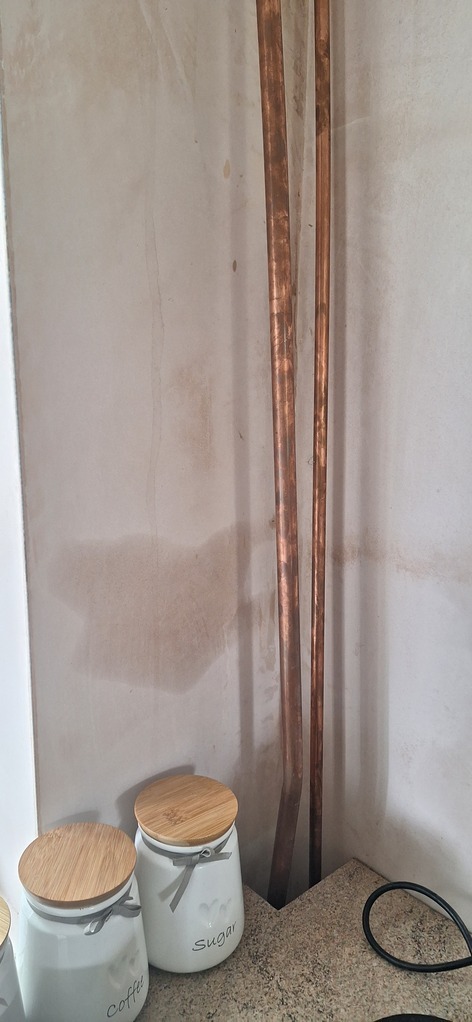  My original plan had been to fork out on dpm injections* and some form of tanking (I can't recall the details) up to 1.2m but timescales prevented that from happening. The alternative was similar to you describe with regards batten and board, but for >£20k from the same company who'd done an average at best job of the crack stitching, that won't be happening either * although I'm sure there's a slate course in already, along with a previous iteration of injections below... (lounge but presumably same in kitchen) Ultimately though I think the best professional advice we've been given to date (by the general surveyor right at the beginning) was to live in it normally for a year and see what's what. The need to do something combined with lack of heating means we've not really had chance to do that unfortunately Cheers, Rob |
| |
|
|
|
|
|
Oct 13, 2023 15:25:26 GMT
|
Ugh, I remember the damp we had in our old place when we moved in - a lot of it caused by the external render being a) hard cement and b) carried down to the ground over the existing slate DPC! The fact the previous owners then built up the external ground over the airbricks and DPC level and capped the external space with concrete didn't help. I found this website a really good read: www.heritage-house.org/damp-and-condensation/types-of-damp-what-have-i-got/about-condensation.htmlI chopped off the external render back above the DPC, kangoed out the concrete slab outside to build a French drain, and repointed the walls using lime - no more damp! The living in it for a while is a good idea too - let's the place come up to the temps & humidity that will be your "norm" to see what happens where - good luck! |
| |
|
|
|
|
|
Oct 13, 2023 16:29:07 GMT
|
|
it looks to me like there might be a lot of historic damp trapped in the walls, it can take years for them to dry out, The surveyors advice sounds spot on, I'dd also get a couple of dehumidifiers to aid the drying out.
|
| |
|
|
|
|
|
Oct 13, 2023 21:34:02 GMT
|
it looks to me like there might be a lot of historic damp trapped in the walls, it can take years for them to dry out, The surveyors advice sounds spot on, I'dd also get a couple of dehumidifiers to aid the drying out. I completely agree with this, it can take a long time for it dry out especially when you have been doing works to the house and there is a lot of moisture in it from plastering, painting, tiling etc.
I've tiled a few toilets/bathrooms and had issues where the toilet cistern gets condensation on it, this tended to go away after 12 months and I put it down to all the moisture introduced by all the work.
Best thing to do is get a dehumidifer running and ventilate the house as well as you can, open windows, run extract fans etc.
Generally i've always found that if a house has a slate damp proof course then any damp issues tend to be for other reasons, leaking guttering, external ground level etc.
One thing to bear in mind is if you have any chimneys the infill at the back of these can bridge the damp proof course because when they were built no one considered that a fire might suffer from damp!
|
| |
|
|
robdhc
Part of things
 
Posts: 198 
|
|
|
|
Thank you as always for the replies - though I'm terrible at replying in a timely manner, without fail I find the advice/input invaluable. That's a helpful link too Morris63 Storm Babet has sped up investigations - some pics to begin with for once. Although leaving the windows on the latch for day one has muddied the findings    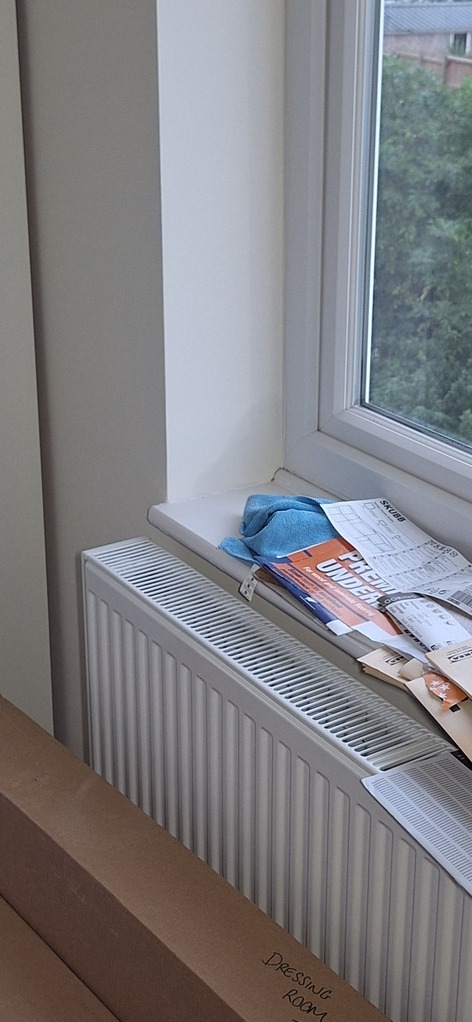 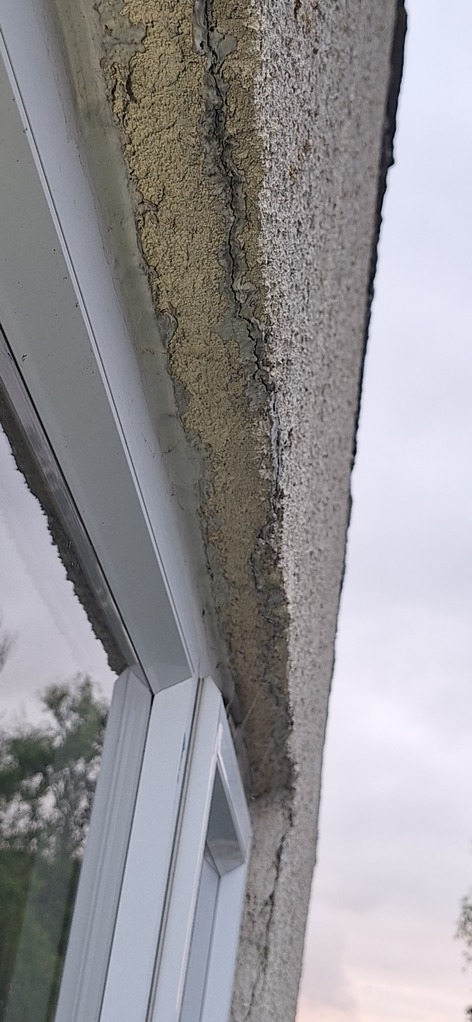    Fortunately we weren't flooded, and I'm fairly sure that due to our (relatively) high position we're at low risk, but this was about 150m away (stretch of c. 200m round the bend, and access to next village)  So what's the situation? Current diagnosis and planned remedies as follows 1. Penetrating damp (as exacerbated by Storm Babet) a result of cracked render, mastic to plug cracks 2. Condensation as a result of historic damp / general dilapidation, as kevins mentioned a. Heating needed ASAP - looks like I've gone full u-turn and will be going air-source heat pump now b. More dehumidifiers! Currently have two running pretty much full time - especially whilst works are still happening as per homersimpson comment 3. Other contributing factors / shoddy building work a. Gutters - and this ones on me.. Needs some fettling b. French drain install c. Extractor fans needed in kitchen and downstairs bathroom It's very much a case of two steps forward, three steps back at the moment, but that's better than three back none forward! So long as we're upstairs by December, I'll only be 6 months behind a 3 month schedule  Cheers, Rob |
| |
Last Edit: Oct 23, 2023 4:51:11 GMT by robdhc
|
|
|
|
|
|
|
|
I still have nothing to add here, except absolute admiration.
The damp walls thing, living in a 100 year old house myself, having had silicone injected on two occasions, only for damp to continue rising (I have learned to live with the paint that flakes off in the one kitchen corner, the rest is OK) will probably continue to be a problem for me.
|
| |
|
|
|
|
|
Oct 23, 2023 17:53:49 GMT
|
Just be careful with an air source heat pump as there are a few major issues which you are probably already aware of: 1. The output water temperature is lower and therefore to get the same heat output into a room the radiators need to be larger. This is why ASHP are more suited to modern well insulated houses. Thats not to say it can't work in an older property but the unit will need to be larger and you need to consider the size in relation to .2 below. 2. The co-efficent of performance drops off (the amount of heat you get out for the amount of energy you put in), when its -5oC outside when you really need the heat it will produce less thant it does at 5oC. The unit is therefore likely to need to be larger than you might think. 3. The units will need to periodically complete a defrost cycle when its cold (below 5oC) to prevent damage and while it does this you have no heat, this won't be for long but depending on how well insulated your house is you might notice the temperature drop. The defrost cycle also uses energy. 4. Some systems use an electric heater to top up the system when its really cold outside, this drastically increases running costs as being direct electric its 1:1 input/output. 5. Most systems can't get the water hot enough to produce/store domestic hotwater in a cylinder so you need to consider how hot water is generated as a cylinder with immersion is an expensive way to do it. Water needs to be typically 60 degrees in a storage cylinder to avoid legionella issues. This is worth a read although of course coming from Calor its not entirely unbiased! www.calor.co.uk/-/media/sites/greatbritain/pdfs/calor-domestic-air-source-heat-pumps-report.pdf |
| |
|
|
raumer
Part of things
 
Posts: 138 
|
|
Oct 25, 2023 17:28:20 GMT
|
|
Glad you didn't get hit by the floods. Saw quite a few roads being closed due to the floods and flooding in the next village over. We've had the river high but nowhere near flooding our land, just a bit boggy at the bottom.
Good luck with sorting out the damp.
Air and ground source heat pumps can work but really need very good insulation to work well. A couple of our friends are engineers for ground source heat pump companies and they are cautious on recommendations. If you can add in solar panels at the same time you can balance out the increased electric heating cost at the worst points.
Ed
|
| |
Mine: 1938 Scammell Pioneer R100, 1944 Scammell Pioneer SV2/S, 1959 Kraz 255b tractor unit, 1960 Unipower Industrial ballast tractor, 1960 88 Landrover Series 2 SWB, 1983 110 Landrover CSW
Look after:
1935 Scammell Rigid 6, 1951 Scammell Scarab, 1961 Landrover Prototype, 1985 Landrover 110
|
|
|
|
|
|
|
Just be careful with an air source heat pump as there are a few major issues which you are probably already aware of: 1. The output water temperature is lower and therefore to get the same heat output into a room the radiators need to be larger. This is why ASHP are more suited to modern well insulated houses. Thats not to say it can't work in an older property but the unit will need to be larger and you need to consider the size in relation to .2 below. 2. The co-efficent of performance drops off (the amount of heat you get out for the amount of energy you put in), when its -5oC outside when you really need the heat it will produce less thant it does at 5oC. The unit is therefore likely to need to be larger than you might think. 3. The units will need to periodically complete a defrost cycle when its cold (below 5oC) to prevent damage and while it does this you have no heat, this won't be for long but depending on how well insulated your house is you might notice the temperature drop. The defrost cycle also uses energy. 4. Some systems use an electric heater to top up the system when its really cold outside, this drastically increases running costs as being direct electric its 1:1 input/output. 5. Most systems can't get the water hot enough to produce/store domestic hotwater in a cylinder so you need to consider how hot water is generated as a cylinder with immersion is an expensive way to do it. Water needs to be typically 60 degrees in a storage cylinder to avoid legionella issues. This is worth a read although of course coming from Calor its not entirely unbiased! www.calor.co.uk/-/media/sites/greatbritain/pdfs/calor-domestic-air-source-heat-pumps-report.pdfwe've looked at fitting one to our 1930's house. By the time you have externaly insulated in (solid walls), ripped all the floors up to insulate, replaced a couple of loft windows, re-plumbed it with larger radiators, find somewhere for a thermal store and hot water tank and then fit he heat pump It could all be well north of 50K, and an enourmous amount of disruption that's just to get bills the same as gas, if I want to reduce the bills then it will be another 20k on solar/ batteries. I know we need to refuce CO2 output but the pumps need to get cheaper and work better before I will go there. As you don't have gas it may be part of your solution but I think you will need some sort of top up heating, at least until you can add more insulation. |
| |
|
|
|
|





























































